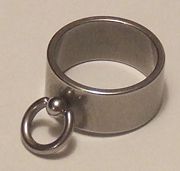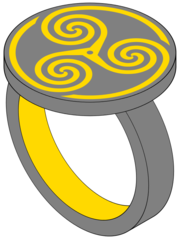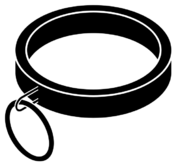Ring of O

The Ring of O is a specially designed ring which is worn mainly in continental Europe — and especially the German-speaking countries — as a distinctive mark among BDSM practitioners since the 1990s. Its use is relatively widespread within this subculture. Its name derives from the name of the central female character in the classic BDSM novel Story of O (written by Pauline Réage), who wore an analogous ring.
Contents[hide] |
Ring description in literature
The ring mentioned in the original novel was quite different from what is most commonly known as the "Ring of O" today. The novel describes the ring as shaped similarly to a signet ring (with a seal disk on top which was relatively large for a woman's ring), made out of dull-gray polished iron, lined with gold on the inside, and with a golden Triskelion (three-fold symbol) on its top area.
The ring's symbolic meaning in the novel differs quite a bit from the one commonly used among BDSM practitioners today. In the book, such a ring is worn by a female slave after she has finished her training at Roissy. Those wearing the ring are obliged to be obedient to any man who belongs to the secret society of Roissy (whose emblem is the triskelion), and must allow him to do absolutely everything with them that he pleases.
This stands in strong contrast to the ring's meaning today. People indicate by wearing such rings that they are interested in BDSM, and sometimes by the hand they wear it on whether they are a Top or a Bottom.
Modern shapes
The first film adaptation of the novel Story of O showed a design consisting of a cylindrical steel ring with an attached ball holding an even smaller toroidal ring (which could swivel in one dimension). Thus it showed similarities to types of collars which in former times were used in order to chain animals or prisoners (see the collar in the image below) and are still common in the BDSM scene today. Inspired by this movie, such small rings became quite popular among BDSM practitioners in German-speaking countries.
The first image of this jewellery design was published in the September issue (No.4) of the German BDSM magazine Schlagzeilen in 1989. Its development is commonly credited to German jewellery designers Jörg Hampel and Jan Scheu.
Since the beginning of the 1990s, the ring's design has been increasingly found outside of BDSM contexts as well. Similar jewellery designs were published in continental Europe, for example by Calvin Klein, and are often offered in shops specializing in selling to young people.
After the ring's most common design started increasingly circulating outside of the BDSM subculture, new design variants developed. These new designs are often incorporate foldaway elements and a more complex structure. This allowed a higher exclusivity and unambiguousness while at the same time the discretion with respect to "vanillas" was significantly increased.
In the UK and the USA, another symbol of BDSM, called the "BDSM Emblem" is far more common. Its design more closely resembles the one described in the novel (without attempting to exactly duplicate it).
Ring of O as a collar
The term O Ring is sometimes used to refer to collars as well (contrasting with D-ring collars). In this context it can describe a collar with one large ring for fastening. Collars featuring such rings are often worn by Bottoms to indicate that they are in a steady relationship.
Literature
- Kathrin Passig and Ira Strübel: Die Wahl der Qual. Rowohlt-Verlag 2004, ISBN 3-499-61692-0 (German)
- Matthias T. J. Grimme: Das SM-Handbuch. Charon-Verlag 2002, ISBN 3-931406-01-6 (German)
External links
- Ring der O on Papiertiger (German)
- Ring der O on Smikipedia (German)
- The Emblem project
- Bondagecollars.com
| |
This page uses content from Wikipedia; the original article can be viewed here. |


